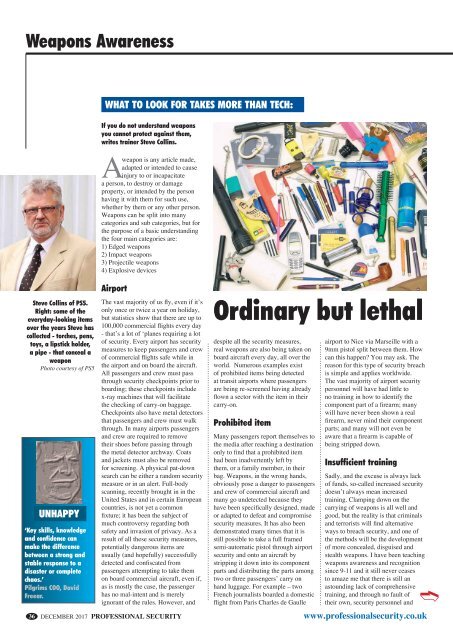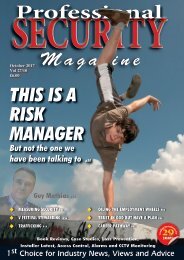Draft27-12
Create successful ePaper yourself
Turn your PDF publications into a flip-book with our unique Google optimized e-Paper software.
Weapons Awareness<br />
what to look for takes more than tech:<br />
If you do not understand weapons<br />
you cannot protect against them,<br />
writes trainer Steve Collins.<br />
A<br />
weapon is any article made,<br />
adapted or intended to cause<br />
injury to or incapacitate<br />
a person, to destroy or damage<br />
property, or intended by the person<br />
having it with them for such use,<br />
whether by them or any other person.<br />
Weapons can be split into many<br />
categories and sub categories, but for<br />
the purpose of a basic understanding<br />
the four main categories are:<br />
1) Edged weapons<br />
2) Impact weapons<br />
3) Projectile weapons<br />
4) Explosive devices<br />
Steve Collins of PS5.<br />
Right: some of the<br />
everyday-looking items<br />
over the years Steve has<br />
collected - torches, pens,<br />
toys, a lipstick holder,<br />
a pipe - that conceal a<br />
weapon<br />
Photo courtesy of PS5<br />
36<br />
UNHAPPY<br />
‘Key skills, knowledge<br />
and confidence can<br />
make the difference<br />
between a strong and<br />
stable response to a<br />
disaster or complete<br />
chaos.’<br />
Pilgrims COO, David<br />
Freear.<br />
Airport<br />
The vast majority of us fly, even if it’s<br />
only once or twice a year on holiday,<br />
but statistics show that there are up to<br />
100,000 commercial flights every day<br />
- that’s a lot of ‘planes requiring a lot<br />
of security. Every airport has security<br />
measures to keep passengers and crew<br />
of commercial flights safe while in<br />
the airport and on board the aircraft.<br />
All passengers and crew must pass<br />
through security checkpoints prior to<br />
boarding; these checkpoints include<br />
x-ray machines that will facilitate<br />
the checking of carry-on baggage.<br />
Checkpoints also have metal detectors<br />
that passengers and crew must walk<br />
through. In many airports passengers<br />
and crew are required to remove<br />
their shoes before passing through<br />
the metal detector archway. Coats<br />
and jackets must also be removed<br />
for screening. A physical pat-down<br />
search can be either a random security<br />
measure or in an alert. Full-body<br />
scanning, recently brought in in the<br />
United States and in certain European<br />
countries, is not yet a common<br />
fixture; it has been the subject of<br />
much controversy regarding both<br />
safety and invasion of privacy. As a<br />
result of all these security measures,<br />
potentially dangerous items are<br />
usually (and hopefully) successfully<br />
detected and confiscated from<br />
passengers attempting to take them<br />
on board commercial aircraft, even if,<br />
as is mostly the case, the passenger<br />
has no mal-intent and is merely<br />
ignorant of the rules. However, and<br />
DECEMBER 2017 PROFESSIONAL SECURITY<br />
Ordinary but lethal<br />
despite all the security measures,<br />
real weapons are also being taken on<br />
board aircraft every day, all over the<br />
world. Numerous examples exist<br />
of prohibited items being detected<br />
at transit airports where passengers<br />
are being re-screened having already<br />
flown a sector with the item in their<br />
carry-on.<br />
Prohibited item<br />
Many passengers report themselves to<br />
the media after reaching a destination<br />
only to find that a prohibited item<br />
had been inadvertently left by<br />
them, or a family member, in their<br />
bag. Weapons, in the wrong hands,<br />
obviously pose a danger to passengers<br />
and crew of commercial aircraft and<br />
many go undetected because they<br />
have been specifically designed, made<br />
or adapted to defeat and compromise<br />
security measures. It has also been<br />
demonstrated many times that it is<br />
still possible to take a full framed<br />
semi-automatic pistol through airport<br />
security and onto an aircraft by<br />
stripping it down into its component<br />
parts and distributing the parts among<br />
two or three passengers’ carry on<br />
hand luggage. For example – two<br />
French journalists boarded a domestic<br />
flight from Paris Charles de Gaulle<br />
airport to Nice via Marseille with a<br />
9mm pistol split between them. How<br />
can this happen? You may ask. The<br />
reason for this type of security breach<br />
is simple and applies worldwide.<br />
The vast majority of airport security<br />
personnel will have had little to<br />
no training in how to identify the<br />
component part of a firearm; many<br />
will have never been shown a real<br />
firearm, never mind their component<br />
parts; and many will not even be<br />
aware that a firearm is capable of<br />
being stripped down.<br />
Insufficient training<br />
Sadly, and the excuse is always lack<br />
of funds, so-called increased security<br />
doesn’t always mean increased<br />
training. Clamping down on the<br />
carrying of weapons is all well and<br />
good, but the reality is that criminals<br />
and terrorists will find alternative<br />
ways to breach security, and one of<br />
the methods will be the development<br />
of more concealed, disguised and<br />
stealth weapons. I have been teaching<br />
weapons awareness and recognition<br />
since 9-11 and it still never ceases<br />
to amaze me that there is still an<br />
astounding lack of comprehensive<br />
training, and through no fault of<br />
their own, security personnel and<br />
www.professionalsecurity.co.uk<br />
➬<br />
p36,8 stevecoll 27-<strong>12</strong>.indd 1 18/11/2017 11:35










